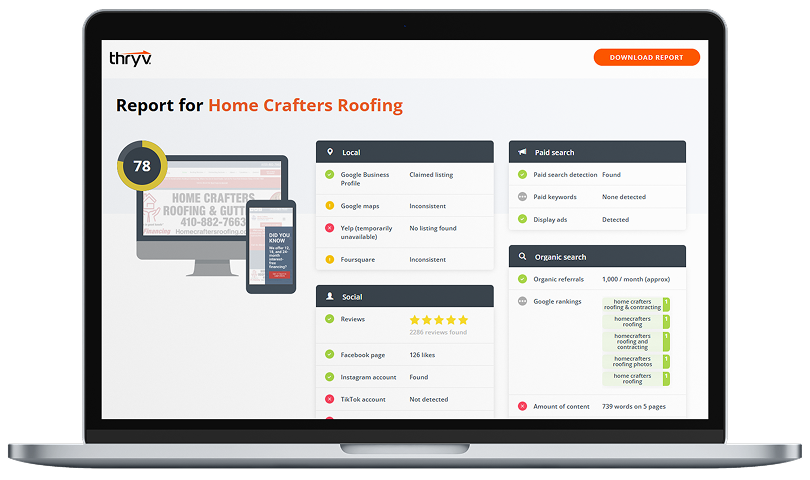When you decided your local business needed a storefront, you had a lot of things to consider. (If you don’t have a storefront, here’s more about branding your digital presence.) You probably chose an area close to home, in a good neighborhood, but that was reasonably priced as well. You looked at the square footage of each space you considered, and you hopefully thought about available parking for your customers. The thought of branding your storefront was likely a problem for future you.

The Ultimate Google
Business Profile
Guide
Learn how to manage and optimize your Google Business Profile in this free guide so you can attract new customers to your brand.
Once you were all moved in, had you budgeted for branding? Most business owners prioritize the necessities: furniture, actual product displays (and product itself), any necessary renovations, and so on. And rightfully so! That leaves whatever’s left over for branding your store.
Well, how much was left? Was it enough? It may be time to dedicate some real time, money and effort to your storefront branding for maximum impact.
A Big Ol’ Caveat
To start, remember everything you do when branding your storefront should fall under the assumption that each decision you make will be consistent with your pre-defined brand. If you haven’t already, decide on and document your brand identity. This includes your logo or brand mark(s), colors, typefaces and fonts, and potentially even brand attributes such as its personality and the feelings its meant to invoke.
1. Killer Signage
From a stand-out monument sign to a chalkboard tent sign on the sidewalk, signage is one of the simplest, most straightforward ways to attract drivers-by and pull in foot traffic.
Top types of signage to consider:
- Monument sign
- Awning sign
- Window display
- Sidewalk tent sign
Also take into consideration:
- Zoning requirements: Check with your Zoning Commission to identify if there are any restrictions on signage size, color, material or messaging.
- Cost: Signage can vary in cost by thousands of dollars, with painted wood or glass on the more economical end, and awning signs and glass tube light signs being most expensive. It’s always best to get a couple quotes before committing to a signage provider. For most local businesses, you’ll be lookin’ good for about $1,500 to $3,000.
- Readability: When designing your signage, ensure it’s easy to read, vibrant and distinct, but not gaudy or overwhelming. Less is much, much more.
- Your brand: If you have a logo and brand guidelines, mimic the same colors and fonts throughout your signage. Pro tip: Don’t default to using your logo in every single piece of signage. A sign that says, “Wood-Fired Pizza” may be just as (or even more) effective at bringing in new customers than your business’s full name, “Mr. Magu’s Pizzeria and Trattoria,” for example. More about that in a second.
2. Judicious Logo Usage
“I’ve got a great logo, so I put it absolutely everywhere possible. That’s good branding!”
– Mr. Marketer
Wait! Not so fast, Mr. Marketer. Some local businesses struggle to turn their brand vision into a reality. So having a logo you’re proud of is commendable. But that doesn’t mean you have to incorporate it into every, single visible aspect of your local business.
When it comes to signage, sometimes less is more. For the main, monument or awning signage, it’s most likely going to work best to spell out your business’s name or your core offering using a plain, easy-to-read typeface that suits your brand. Then, on any window displays or supporting signage, you can get a little more intricate by incorporating your full logo and some additional descriptions of what you offer.
3. Cleanliness
What’s that saying… “Cleanliness is next to godliness”? Well, we can’t speak to that. But we can speak to the fact that customers respond better to businesses that give a good first impression.
Unfortunately, keeping your store clean and tidy is a bit of a thankless endeavor. Not everyone will notice when things are spotless. But if things aren’t clean, you’ll scare potential customers away faster than ever.

The Ultimate Google
Business Profile
Guide
Learn how to manage and optimize your Google Business Profile in this free guide so you can attract new customers to your brand.
4. Dazzling Window Displays
Many local business owners forget the opportunity a window provides you to showcase your business up close. For someone driving through a parking lot or strolling by your store, your window is a prime opportunity to spotlight what you do best.
Avoid assuming that if someone can see into your window that they can see what you’re doing. Glares, varying types of glass and weather can all affect someone’s ability to see into your store.
To take full advantage, consider creating a display right in front of your window that showcases any featured products. If you’re a florist, for example, consider moving some of your most vibrant and freshest bouquets to a stand right in front of the window. Play up holidays and special occasions to draw consumers in. Even if your business isn’t in retail, show off the services you provide with promotional materials and window clings.
5. Landscaping
Many local business owners lease their spaces, which means it’s easy to dismiss landscaping as something that’s up to the property owners. But simple, clean landscaping can go a long way in upping your curb appeal. Fresh flowers, clean sidewalks and green grass can make your space stand out in an otherwise bland strip of stores.
Pro tip: Most property owners won’t mind you offering to brighten up the space on your own dime. Just remember to check in before conducting any major landscaping overhauls.
6. A Fresh Coat of Paint
Don’t settle for old, chipping or faded paint when it comes to your storefront. If you’re renting, consult with your landlord or property owner, and find a color that both suits your brand and the location.
The paint color you choose should attract your ideal customer as well. Younger consumers are enticed by brighter, more energetic, warm colors like orange. Whereas older consumers often prefer more relaxed, subtle colors that are less dramatic.
7. Lighting
Now that you’ve freshened up your signage, landscaping and paint, take a step back from your store and give it a good once-over. How does it look? Does it stand out from those around it? How visible is it from the street? Will your hard work building window displays get lost when the sun goes down?
Though not cheap, installing up-lighting in the front of your store can make you stand out from the competition and your neighbors. Similarly, the lighting you use inside can keep people in your store comfortable and convey clear messages about your business. FitSmallBusiness has tons of tips on the best fixtures, bulbs and applications for your type of business.
Bonus Tip: Lengthy Lines
Yup, long lines outside your store can boost your brand. You’re probably thinking, “Huh? That’s not under my control.”
Sure, you’d love for your store to be busy all the time. But what do lines of customers outside your store have to do with branding? It’s about building social proof, thus adding to your business’s perceived credibility. Learn more about what social proof is and how to generate it in a recent blog.
The best example of this tactic is local breakfast restaurants. Have you ever noticed how small the waiting areas are in most of them? Not only does it maximize their space for seating, it forces people to wait outside where passing traffic can see them. Nothing screams “worth-the-wait waffles” like a crowd outside and a 45-minute wait.

The Ultimate Google
Business Profile
Guide
Learn how to manage and optimize your Google Business Profile in this free guide so you can attract new customers to your brand.


